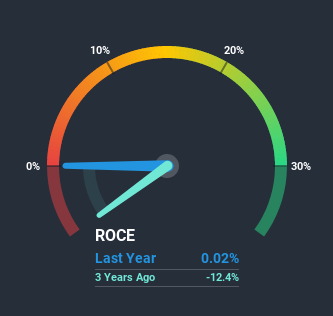The Trends At Marlborough Wine Estates Group (NZSE:MWE) That You Should Know About

What are the early trends we should look for to identify a stock that could multiply in value over the long term? Ideally, a business will show two trends; firstly a growing return on capital employed (ROCE) and secondly, an increasing amount of capital employed. If you see this, it typically means it's a company with a great business model and plenty of profitable reinvestment opportunities. Having said that, from a first glance at Marlborough Wine Estates Group (NZSE:MWE) we aren't jumping out of our chairs at how returns are trending, but let's have a deeper look.
Understanding Return On Capital Employed (ROCE)
For those that aren't sure what ROCE is, it measures the amount of pre-tax profits a company can generate from the capital employed in its business. The formula for this calculation on Marlborough Wine Estates Group is:
Return on Capital Employed = Earnings Before Interest and Tax (EBIT) ÷ (Total Assets - Current Liabilities)
0.00023 = NZ$6.4k ÷ (NZ$28m - NZ$1.4m) (Based on the trailing twelve months to June 2020).
Therefore, Marlborough Wine Estates Group has an ROCE of 0.02%. In absolute terms, that's a low return and it also under-performs the Beverage industry average of 9.1%.
Check out our latest analysis for Marlborough Wine Estates Group
Historical performance is a great place to start when researching a stock so above you can see the gauge for Marlborough Wine Estates Group's ROCE against it's prior returns. If you want to delve into the historical earnings, revenue and cash flow of Marlborough Wine Estates Group, check out these free graphs here.
What Does the ROCE Trend For Marlborough Wine Estates Group Tell Us?
In terms of Marlborough Wine Estates Group's historical ROCE movements, the trend isn't fantastic. Over the last five years, returns on capital have decreased to 0.02% from 17% five years ago. However, given capital employed and revenue have both increased it appears that the business is currently pursuing growth, at the consequence of short term returns. If these investments prove successful, this can bode very well for long term stock performance.
On a related note, Marlborough Wine Estates Group has decreased its current liabilities to 5.1% of total assets. So we could link some of this to the decrease in ROCE. What's more, this can reduce some aspects of risk to the business because now the company's suppliers or short-term creditors are funding less of its operations. Since the business is basically funding more of its operations with it's own money, you could argue this has made the business less efficient at generating ROCE.
In Conclusion...
Even though returns on capital have fallen in the short term, we find it promising that revenue and capital employed have both increased for Marlborough Wine Estates Group. These growth trends haven't led to growth returns though, since the stock has fallen 23% over the last three years. So we think it'd be worthwhile to look further into this stock given the trends look encouraging.
If you want to continue researching Marlborough Wine Estates Group, you might be interested to know about the 2 warning signs that our analysis has discovered.
While Marlborough Wine Estates Group may not currently earn the highest returns, we've compiled a list of companies that currently earn more than 25% return on equity. Check out this free list here.
This article by Simply Wall St is general in nature. It does not constitute a recommendation to buy or sell any stock, and does not take account of your objectives, or your financial situation. We aim to bring you long-term focused analysis driven by fundamental data. Note that our analysis may not factor in the latest price-sensitive company announcements or qualitative material. Simply Wall St has no position in any stocks mentioned.
Have feedback on this article? Concerned about the content? Get in touch with us directly. Alternatively, email editorial-team@simplywallst.com.


